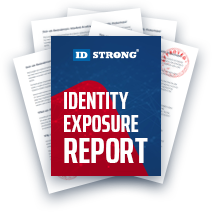Identity Theft Reporting Guide: Key Steps to Protect Your Identity
Table of Contents
- By Steven
- Published: Nov 20, 2023
- Last Updated: Dec 13, 2023

Identity theft is a real and distressing crime that's becoming a greater risk as more sensitive data moves to online locations. It occurs when someone obtains and uses your personal information for fraud. These criminals seek to abuse innocent people's credit, ruin reputations, or utilize an identity to extend the scope of their crime to the victim's friends and family.
These attacks target well-protected information like social security numbers, bank account details, and login credentials. However, even the most inane and easily captured details can lead to identity theft. Your pet's name, childhood address, and mother's maiden name are simple to find through social media and can be used to answer knowledge-based security questions.
In this guide, we aim to teach everyone how to recognize and respond to identity theft to minimize the damage to your finances and mental state. Even if you haven't been a victim of identity theft in the past, it's essential to have this information in your back pocket because, in today's technological landscape, it's not a matter of if, but when.
Signs of Identity Theft
One of the more nefarious effects of identity theft is how long it can go unnoticed. It's like it has a submarine mode and only surfaces when things get too fishy. The problem is that victims aren't usually on the lookout for the small red flags caused by identity theft. Recognizing these signs can help you detect identity theft early and take necessary action. Here are some key indicators that your identity may have been stolen:
Unexplained Financial Transactions and Withdrawals
Most people aren't in the habit of reviewing their credit card transactions with a fine comb. So, when incorrect charges come up, they're often missed. Make it a habit to check your transaction history occasionally and ensure everything's alright. We recommend doing this at least once a week. Using a short time period makes it so that you're likely not remembering pages and pages of transaction history.
Suspicious Emails or Calls
If you're getting a suspicious number of phishing emails or unsolicited calls, at the very least, you're at risk of identity theft. This likely means that someone has gotten a hold of your contact information and is using it to bait you with social engineering tactics. Otherwise, they may have sold it on the dark web to allow other attackers to go after you. The same is true for unexpected calls from posing as authorities from some financial institution or government group.
Missing Mail
When you stop receiving important financial statements or bills, please take it as a sign that someone has altered your mailing address. Criminals do this to prevent you from seeing their transactions or worrying notices from the credit provider. If you're missing regularly sent mail, logging into your online portal and checking the listed contact information is worth it.
Unknown Accounts or Credit Lines
People who regularly check their credit reports know it's a fairly detailed report of debt standings, credit accounts, and general financial health. One of the perks of closely monitoring this report is that you can notice when criminals open credit lines without your knowledge. This can save you a lot of headaches in the long run and help you nip the problem in the bud. However, credit reports can only be requested a few times per year without a charge, so we recommend opting for a dark web monitoring service or social security number tracker.
Immediate Actions to Take

Anyone who suspects or has confirmed that their identity was stolen must take expedient action to minimize the damage. After all, the less time the thief has to work with, the less they can harm your reputation and finances.
Initiate a Credit Alert or Freeze
Anyone unfamiliar with protecting their credit report might not recognize the terms credit alert and credit freeze. However, these are your best tools to defend yourself from identity theft and act as a preemptive and responsive measure.
A credit alert is a note left on your profile for the three major credit bureaus (Equifax, Experian, & TransUnion). This alert directs them to contact you if any request is made for your credit report by something like a bank or a rental administrator. However, credit alerts are not government-protected, which means the individual bureaus are not responsible for alerting the other two. So, you'll need to set up the freezes one at a time.
A credit freeze is a complete lockdown of your credit report. An alert still allows creditors to access your credit report with your permission, but a freeze will block everything until it's thawed. This is a government-protected action, so if you initiate a freeze through one bureau, that organization must notify the others. A credit freeze isn't difficult to lift, but forgetting about it may slow down your approval processes for credit-based purchases.
Notify Financial Institutions
Blocking your credit report can stop criminals from opening new accounts in your name. However, the best way to protect your existing accounts is to contact your financial institutions directly. This includes banks, credit card companies, and any third-party creditors you've worked with. Each organization has a different way of dealing with identity theft, but most recommend is monitoring service or closing an affected account. Regardless of their advice, you should request new cards, account numbers, login credentials, and PINs.
Contact Law Enforcement
Contact your local law enforcement agency to report the identity theft if you haven't already. A police report is a handy tool for reporting theft to creditors. If you're personally going to the station, it's a good idea to file a report with the Federal Trade Commission (FTC) beforehand, as that may be required depending on your state.
Ensure you're carefully documenting all communications and transactions related to the identity theft. Evidence will include fraudulent purchase dates, times, locations, and communications with the attacker, such as phishing emails or phone calls. Diligent documentation will be vital to recouping damages in the future.
Tips to Secure Your Personal Information
Preventative measures are just as crucial as knowing how to respond to the event. Here are some tips to help you secure your personal information and stay off a cybercriminal's radar.
Safeguard Your Social Security Number
Never carry your social security card in your wallet or share it needlessly. Some processes, such as credit checks, require your social security number to proceed. However, many times, it's not needed, so you should ALWAYS ask what it's being used for. If you must share it, ensure you're not writing it down on a non-official document and that customer service representatives aren't reading it back to you over the phone.
Shred Sensitive Documents
If you're a high-priority target, or someone has a grudge against you, there's a chance a criminal will look through your trash for clues. Studies have shown that a great deal of cyberbullying and attacks stem from petty reasons. Use a cross-cut shredder to destroy papers with your personal information, such as bank statements or medical records.
Keep Cyber Etiquette in Mind
It can feel like there are too many rules to follow online nowadays. I can think of at least eight rules for passwords alone off the top of my head. However, it's vital that you at least remain wary of emails and links. Most attacks on individuals result from social engineering attacks like phishing and vishing attacks. Never click on unconfirmed links, and download an antivirus that can monitor your email. Many malware solutions offer free versions that provide passive scanning of your communications.
Monitor Your Accounts and Credit Report
Regularly review your financial statements for any unauthorized transactions. Try to do this weekly or bi-weekly, but go through each transaction done since your most recent check. Intelligent criminals will make small enough purchases that you won't notice if you only look at your account totals.
Additionally, all three credit bureaus offer a free annual credit report. This allows you to check your credit report at least three times a year to get an in-depth look at your financial health.
Secure Personal Devices
Maintain strong and unique passwords across your devices. It's estimated that the average user has over 100 passwords, many of which are defended by weak credentials. An easy fix is to use a dedicated password generator to auto-generate robust passwords and fill out the login forms when you access a site.
Utilize a Credit Monitoring Service
Enrolling in a credit monitoring service alerts you to suspicious activity on your credit reports. This is an excellent method for staying in the loop, even when you can't access one of your free credit reports. It provides peace of mind and eliminates the hassle of constantly checking your transaction history.
Although, we still recommend looking at your spending habits occasionally, even if you're using a credit monitoring service.
Keep Your Personal Data Safe at All Times
Safeguarding your identity is paramount in an age where so much of our personal information is easily found. Detecting the signs of identity theft early and taking immediate action are crucial considerations in minimizing the damage. Identity theft hurts you but frequently extends to your close contacts and family.
If you recognize the signs of identity theft, you should immediately contact the credit bureaus and initiate a credit freeze or alert. This will prevent the attacker from taking any drastic actions with your information. After that, you should report the incident to both a police station and your associated financial institutions. These authorities will alert you on the next steps for your situation.
Remember that identity theft is a persistent risk that affects everybody. You can significantly reduce vulnerability by setting up credit monitoring services or dark web scans. Contact our team at IDStrong to learn more about setting up these tools to protect your identity and gain the peace of mind you need.



















































































































